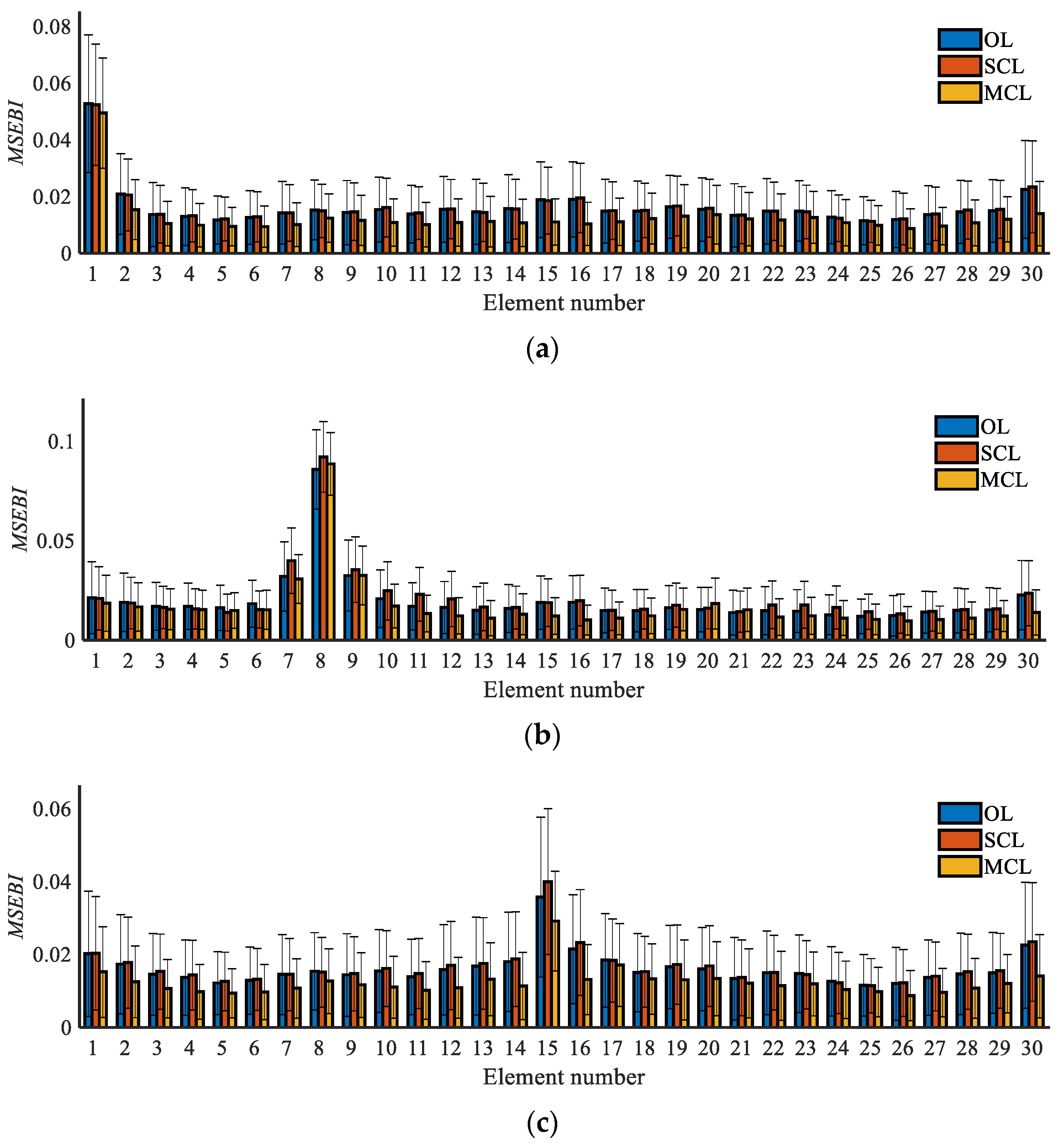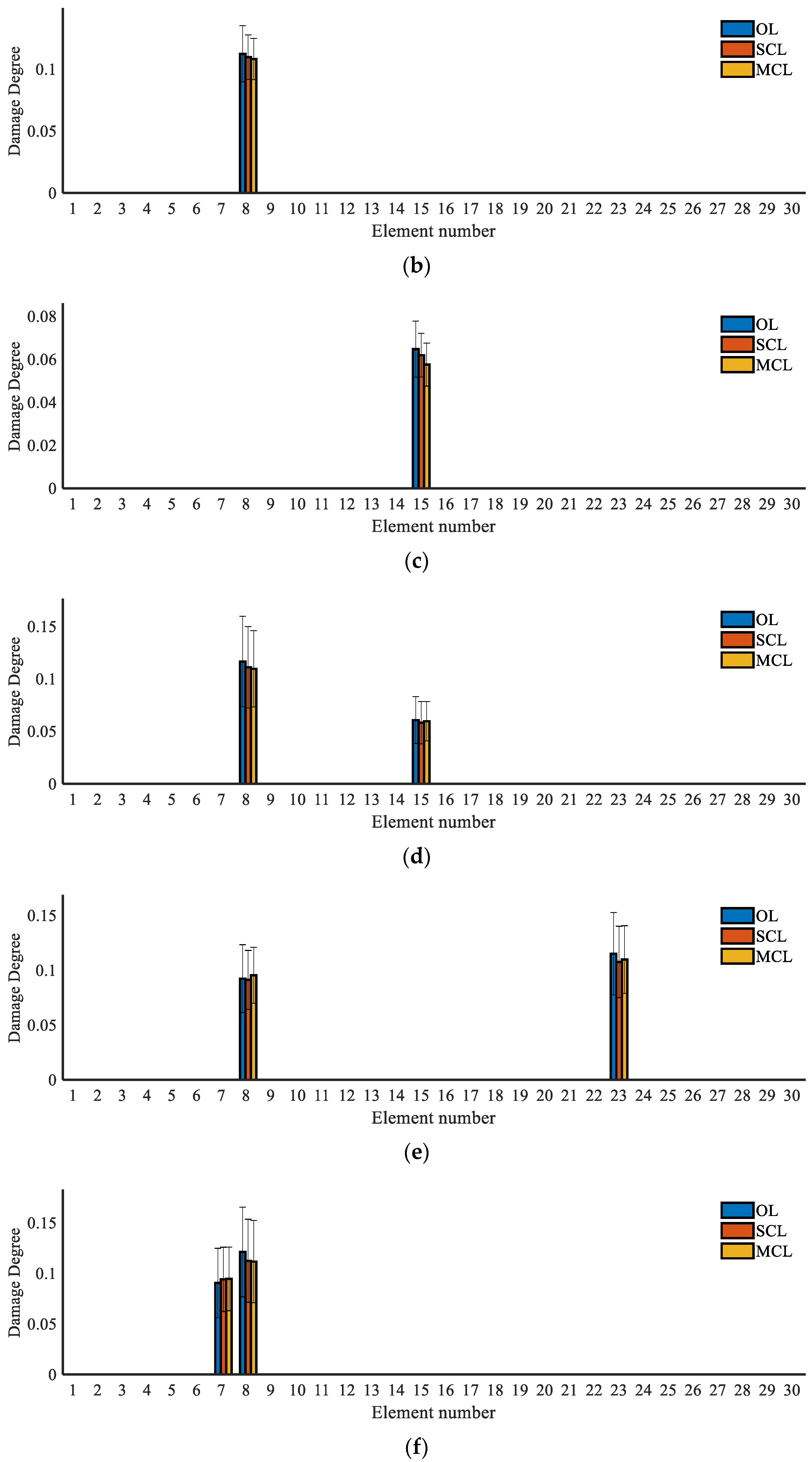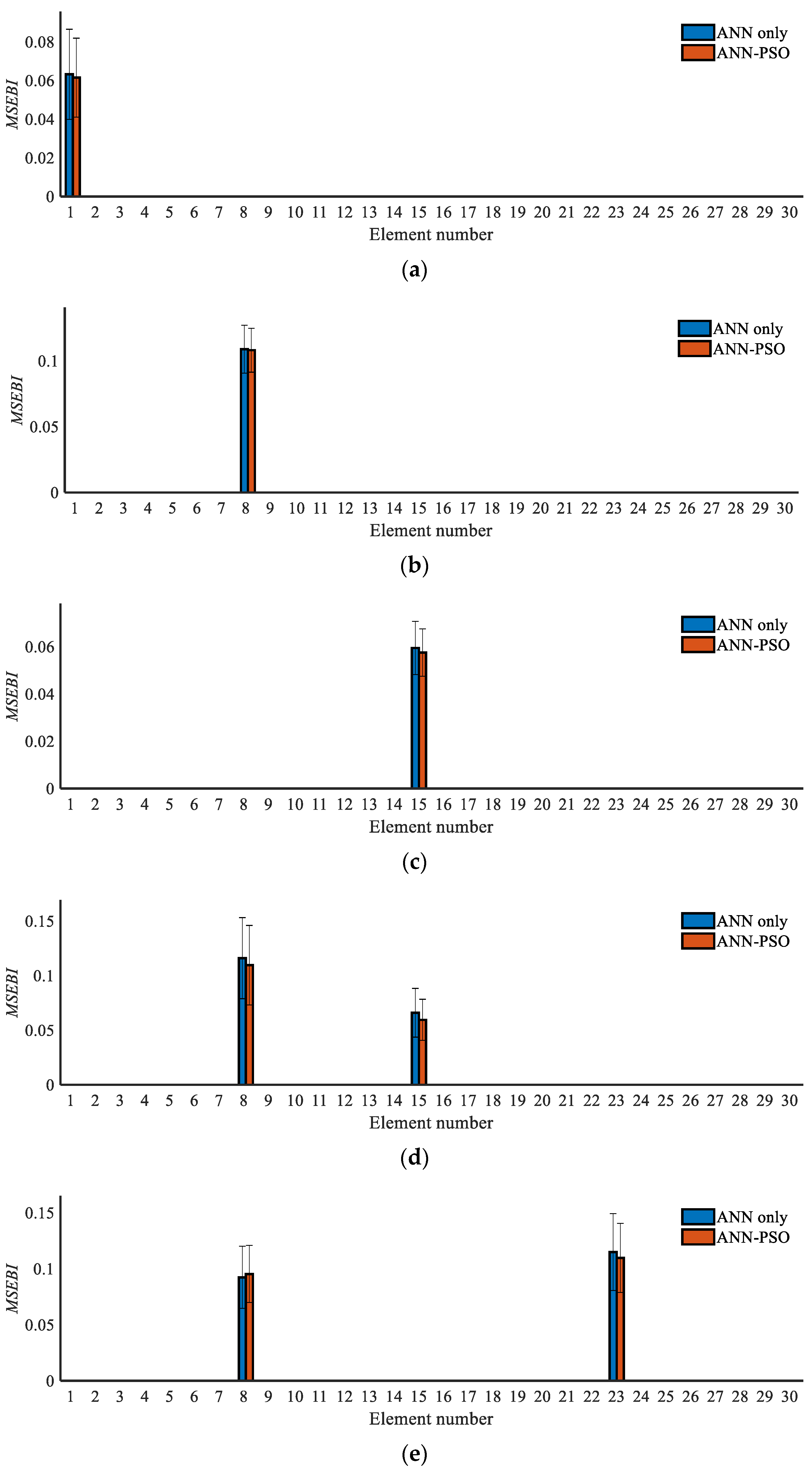A Two-Stage Approach for Damage Diagnosis of Structures Based on a Fully Distributed Strain Mode under Multigain Feedback Control
Abstract
:1. Introduction
2. A Two-Stage Damage Diagnosis Method Using Strain-Based, Closed-Loop Systems under Multigain Feedback Control
2.1. Eigenstructure Assignment Using Strain Output Feedback
2.2. Construction of Closed-Loop Systems
2.3. MSEBI Method for Damage Localization
2.4. Hybrid ANN-PSO Algorithm for Damage Quantification
2.5. Flowchart of the Proposed Damage Diagnosis Approach
3. Numerical Simulation
3.1. Brief Description of a Structural Example
3.2. Assignment of the Multiple Closed-Loop System
3.3. Damage Cases
3.4. Damage Diagnosis Results
3.4.1. Damage Localization Results
3.4.2. Damage Quantification Results
3.4.3. Comparative Discussion with One-Stage Damage Diagnosis Using Sensitivity Matrix
3.4.4. Comparative Discussion with the ANN-Only Algorithm for Damage Quantification
4. Concluding Remarks
- (i)
- A multigain closed-loop system is established to improve the sensitivity of strain mode shapes for structural damage in different spans, with which the MSEBI method and hybrid ANN-PSO algorithm are proposed to locate and quantify the small damage of the multispan structure, and the performance of the proposed method is validated through a numerical example of a two-span beam structure;
- (ii)
- The MCL system performs more effectively than the OL and SCL systems for detecting local damage, while the MCL system requires fewer actuators than the SCL system, making it more economical and practical for structure testing;
- (iii)
- Compared with the one-stage, sensitivity-based damage detection approach, the two-stage method has a better effect and accuracy, which can help avoid misjudgment for undamaged elements and realize fast damage detection;
- (iv)
- The hybrid PSO-ANN algorithm has a better detection effect, while the ANN-only algorithm may easily become trapped in local minima and become less accurate;
- (v)
- The proposed closed-loop damage diagnosis method is carried out in real time online, which is difficult to implement in practice; thus, further research on method implementation based on virtual output feedback should be investigated in the future.
Author Contributions
Funding
Institutional Review Board Statement
Informed Consent Statement
Data Availability Statement
Conflicts of Interest
References
- Ellingwood, B.R. Risk-informed condition assessment of civil infrastructure: State of practice and research issues. Struct. Infrastruct. Eng. 2005, 1, 7–18. [Google Scholar] [CrossRef]
- Frangopol, D.M.; Liu, M. Maintenance and management of civil infrastructure based on condition, safety, optimization, and life-cycle cost. Struct. Infrastruct. Eng. 2007, 3, 29–41. [Google Scholar] [CrossRef]
- Frangopol, D.M.; Saydam, D.; Kim, S. Maintenance, management, life-cycle design and performance of structures and infrastructures: A brief review. Struct. Infrastruct. Eng. 2012, 8, 1–25. [Google Scholar] [CrossRef]
- Kim, J.M.; Son, K.; Yoo, Y.; Lee, D.; Kim, D.Y. Identifying risk indicators of building damage due to typhoons: Focusing on cases of south Korea. Sustainability 2018, 10, 3947. [Google Scholar] [CrossRef]
- Sony, S.; Laventure, S.; Sadhu, A. A literature review of next-generation smart sensing technology in structural health monitoring. Struct. Control Health Monit. 2019, 26, e2321.1–e2321.22. [Google Scholar] [CrossRef]
- Mishraa, M.; Lourençob, P.B.; Ramana, G.V. Structural health monitoring of civil engineering structures by using the internet of things: A review. J. Build. Eng. 2021, 48, 103954. [Google Scholar] [CrossRef]
- Amezquita-Sanchez, J.P.; Adeli, H. Signal Processing Techniques for Vibration-Based Health Monitoring of Smart Structures. Arch. Comput. Methods Eng. 2016, 23, 1–15. [Google Scholar] [CrossRef]
- Mishra, M. Machine learning techniques for structural health monitoring of heritage buildings: A state-of-the-art review and case studies. J. Cult. Herit. 2021, 47, 227–245. [Google Scholar] [CrossRef]
- Lian, J.J.; Cai, O.; Dong, X.F.; Jiang, Q.; Zhao, Y. Health monitoring and safety evaluation of the offshore wind turbine structure: A review and discussion of future development. Sustainability 2019, 11, 494. [Google Scholar] [CrossRef]
- Abdeljaber, O.; Avci, O.; Kiranyaz, S.; Gabbouj, M.; Inman, D.J. Real-time vibration-based structural damage detection using one-dimensional convolutional neural networks. J. Sound Vib. 2017, 388, 154–170. [Google Scholar] [CrossRef]
- Zhang, Y.; Miyamori, Y.; Mikami, S.; Saito, T. Vibration-based structural state identification by a 1-dimensional convolutional neural network. Comput.-Aided Civ. Infrastruct. Eng. 2019, 34, 822–839. [Google Scholar] [CrossRef]
- Fan, W.; Qiao, P. Vibration-based Damage Identification Methods: A Review and Comparative Study. Struct. Health Monit. 2011, 9, 83–111. [Google Scholar] [CrossRef]
- Zhu, D.; Yi, X.; Wang, Y. A local excitation and measurement approach for decentralized damage detection using transmissibility functions. Struct. Control. Health 2016, 23, 487–502. [Google Scholar] [CrossRef]
- Ray, L.R.; Tian, L. Damage detection in smart structures through sensitivity enhancing feedback control. J. Sound Vib. 1999, 227, 987–1002. [Google Scholar] [CrossRef]
- Koh, B.H. Damage Identification in Smart Structures Through Sensitivity Enhancing Control. Master’s Thesis, Thayer School of Engineering, Dartmouth College, Hanover, NH, USA, 2003. [Google Scholar]
- Koh, B.H.; Ray, L.R. Feedback controller design for sensitivity based damage localization. J. Sound Vib. 2004, 273, 317–335. [Google Scholar] [CrossRef]
- Ray, L.R.; Koh, B.H.; Tian, L. Damage detection and vibration control in smart plates: Towards multifunctional smart structures. J. Intell. Mater. Syst. Struct. 2000, 11, 725–739. [Google Scholar] [CrossRef]
- Koh, B.H.; Ray, L.R. Localization of damage in smart structures through sensitivity enhancing feedback control. Mech. Syst. Signal Process. 2003, 17, 837–855. [Google Scholar] [CrossRef]
- Ray, L.R.; Marin, I.S. Optimization of control laws for damage detection in smart structures. In Proceedings of the SPIE-the International Society for Optical Engineering, San Jose, CA, USA, 25–28 January 2000; Volume 3984, pp. 395–402. [Google Scholar]
- Solbeck, J.A.; Ray, L.R. Damage identification using sensitivity-enhancing control and identified models. J. Vib. Acoust. Trans. ASME 2006, 128, 210–220. [Google Scholar] [CrossRef]
- Jiang, L.J.; Tang, J.; Wang, K.W. An Optimal Sensitivity-Enhancing Feedback Control Approach via Eigenstructure Assignment for Structural Damage Identification. J. Vib. Acoust. 2007, 129, 771–783. [Google Scholar] [CrossRef]
- Jiang, L.J.; Wang, K.W. An experiment-based frequency sensitivity enhancing control approach for structural damage detection. Smart Mater. Struct. 2009, 18, 065005. [Google Scholar] [CrossRef]
- Bernal, D. Eigenvalue sensitivity of sampled time systems operating in closed loop. Mech. Syst. Signal Process. 2018, 105, 481–487. [Google Scholar] [CrossRef]
- Bernal, D. State observers in the design of eigenstructures for enhanced sensitivity. Mech. Syst. Signal Process. 2018, 110, 122–129. [Google Scholar] [CrossRef]
- Bernal, D.; Ulriksen, M.D. Output feedback in the design of eigenstructures for enhanced sensitivity. Mech. Syst. Signal Process. 2018, 112, 22–30. [Google Scholar] [CrossRef]
- Masoudi, A.; Belal, M.; Newson, T.P. A distributed optical fibre dynamic strain sensor based on phase-OTDR. Meas. Sci. Technol. 2013, 24, 085204. [Google Scholar] [CrossRef]
- Soto, M.A.; Thévenaz, L. Modeling and evaluating the performance of Brillouin distributed optical fiber sensors. Opt. Express 2013, 21, 31347–31366. [Google Scholar] [CrossRef]
- Castillo-Mingorance, J.M.; Sol-Sánchez, M.; Moreno-Navarro, F.; Rubio-Gámez, M.C. A Critical Review of Sensors for the Continuous Monitoring of Smart and Sustainable Railway Infrastructures. Sustainability 2020, 12, 9428. [Google Scholar] [CrossRef]
- Glisic, B.; Hubbell, D.; Sigurdardottir, D.; Yao, Y. Damage detection and characterization using long-gauge and distributed fiber optic sensors. Opt. Eng. 2013, 52, 087101. [Google Scholar] [CrossRef]
- Hoult, N.A.; Ekim, O.; Regier, R. Damage/Deterioration Detection for Steel Structures Using Distributed Fiber Optic Strain Sensors. J. Eng. Mech. 2014, 140, 04014097. [Google Scholar] [CrossRef]
- Gu, J.; Gul, M.; Wu, X. Damage detection under varying temperature using artificial neural networks. Struct. Control Health 2017, 24, e1998. [Google Scholar] [CrossRef]
- Cha, Y.J.; Choi, W.; Büyüköztürk, O. Deep Learning-Based Crack Damage Detection Using Convolutional Neural Networks. Comput-Aided Civ. Inf. 2017, 32, 361–378. [Google Scholar] [CrossRef]
- Khodabandehlou, H.; Pekcan, G.; Fadali, M.S. Vibration-based structural condition assessment using convolution neural networks. Struct. Control Health 2019, 26, e2308. [Google Scholar] [CrossRef]
- Khatir, S.; Boutchicha, D.; Thanh, C.L.; Tran-Ngoc, H.; Nguyen, T.N.; Abdel-Wahab, M. Improved ANN technique combined with Jaya algorithm for crack identification in plates using XIGA and experimental analysis. Theor. Appl. Fract. Mech. 2020, 107, 102554. [Google Scholar] [CrossRef]
- Mishra, M.; Barman, S.K.; Maity, D.; Maiti, D.K. Performance Studies of 10 Metaheuristic Techniques in Determination of Damages for Large-Scale Spatial Trusses from Changes in Vibration Responses. J. Comput. Civ. Eng. 2020, 34, 04019052. [Google Scholar] [CrossRef]
- Barman, S.K.; Mishra, M.; Maiti, D.K.; Maity, D. Vibration-based damage detection of structures employing Bayesian data fusion coupled with TLBO optimization algorithm. Struct. Multidiscip. Optim. 2021, 64, 2243–2266. [Google Scholar] [CrossRef]
- Wang, S.Q.; Liu, F.S.; Zhang, M. Modal Strain Energy Based Structural Damage Localization for Offshore Platform using Simulated and Measured Data. J. Ocean Univ. China 2014, 13, 397–406. [Google Scholar] [CrossRef]
- Zhang, J.; Li, P.J.; Wu, Z.S. A new flexibility-based damage index for structural damage detection. Smart Mater. Struct. 2013, 22, 025037. [Google Scholar] [CrossRef]
- Naderi, A.; Sohrabi, M.R.; Ghasemi, M.R.; Dizangian, B. A swift technique for damage detection of determinate truss structures (2). Eng. Comput. 2021, 38 (Suppl. 2), 1427–1436. [Google Scholar] [CrossRef]
- Seyedpoor, S.M.A. Two stage method for structural damage detection using a modal strain energy based index and particle swarm optimization. Int. J. Non-Linear Mech. 2012, 47, 1–8. [Google Scholar] [CrossRef]
- Shi, Z.Y.; Law, S.S.; Zhang, L.M. Structural damage localization from modal strain energy change. J. Sound Vib. 1998, 218, 825–844. [Google Scholar] [CrossRef]
- Shi, Z.Y.; Law, S.S.; Zhang, L.M. Improved damage quantification from elemental modal strain energy change. J. Eng. Mech.-ASCE 2002, 128, 521–529. [Google Scholar] [CrossRef]
- Wu, S.Q.; Zhou, J.X.; Rui, S.; Fei, Q.G. Reformulation of elemental modal strain energy method based on strain modes for structural damage detection. Adv. Struct. Eng. 2017, 20, 896–905. [Google Scholar] [CrossRef]



















| Parameter | Young’s Modulus | Sectional Area | Moment of Inertia | Density | Damping Ratio |
|---|---|---|---|---|---|
| Value | 3.25 × 1010 MPa | 0.4 m2 | 6.69 × 10−2 m4 | 2370 kg/m3 | 0.01 |
| System Type | Open-Loop Actuators Nodes | Closed-Loop Actuators Nodes | Amplification Coefficient | Optimal Results |
|---|---|---|---|---|
| OL | 9 | - | - | - |
| SCL | 9 | 5, 12, 20, 27 | ||
| MCL | 9 | 5, 12 | ||
| 23 | 20, 27 |
| Damage Case | Damaged Elements | Case Type | Damaged Degrees (%) |
|---|---|---|---|
| 1 | 1 | Single | 5 |
| 2 | 8 | Single | 10 |
| 3 | 15 | Single | 5 |
| 4 | 8, 15 | Double | 10, 5 |
| 5 | 8, 23 | Double | 10, 10 |
| 6 | 7, 8 | Double | 10, 10 |
| 7 | 8, 15, 23 | Triple | 10, 5, 10 |
| Damage Case | Actual Loctation | OL-Identified Loctation | SCL-Identified Loctation | MCL-Identified Loctation |
|---|---|---|---|---|
| 1 | 1 | 1 | 1 | 1 |
| 2 | 8 | 8 | 8 | 8 |
| 3 | 15 | 15 | 15 | 15 |
| 4 | 8, 15 | 8, 15 | 8, 15 | 8, 15 |
| 5 | 8, 23 | 8, 23 | 8, 23 | 8, 23 |
| 6 | 7, 8 | 7, 8 | 7, 8 | 7, 8 |
| 7 | 8, 15, 23 | 8, 15, 23 | 8, 15, 23 | 8, 15, 23 |
| Damage Case | Actual Damaged Elements | Actual Damaged Degree (%) | OL | SCL | MCL | |||
|---|---|---|---|---|---|---|---|---|
| Identified Results (%) | Error Norm | Identified Results (%) | Error Norm | Identified Results (%) | Error Norm | |||
| 1 | 1 | 5 | 7.15 | 2.15 | 6.22 | 1.22 | 6.15 | 1.15 |
| 2 | 8 | 10 | 11.23 | 1.23 | 10.96 | 0.96 | 10.81 | 0.81 |
| 3 | 15 | 5 | 6.47 | 1.47 | 6.19 | 1.19 | 5.75 | 0.75 |
| 4 | 8 | 10 | 11.65 | 1.96 | 11.10 | 1.37 | 10.95 | 1.35 |
| 15 | 5 | 6.06 | 5.81 | 5.95 | ||||
| 5 | 8 | 10 | 9.23 | 1.69 | 9.11 | 1.16 | 9.53 | 1.08 |
| 23 | 10 | 11.50 | 10.75 | 10.97 | ||||
| 6 | 7 | 10 | 9.04 | 2.31 | 9.40 | 1.38 | 9.45 | 1.29 |
| 8 | 10 | 12.10 | 11.24 | 11.16 | ||||
| 7 | 8 | 10 | 9.67 | 2.38 | 9.34 | 1.98 | 9.48 | 1.40 |
| 15 | 5 | 6.61 | 6.55 | 5.86 | ||||
| 23 | 10 | 11.72 | 11.04 | 10.96 | ||||
Publisher’s Note: MDPI stays neutral with regard to jurisdictional claims in published maps and institutional affiliations. |
© 2022 by the authors. Licensee MDPI, Basel, Switzerland. This article is an open access article distributed under the terms and conditions of the Creative Commons Attribution (CC BY) license (https://creativecommons.org/licenses/by/4.0/).
Share and Cite
Zhou, Z.; Dong, K.; Fang, Z.; Liu, Y. A Two-Stage Approach for Damage Diagnosis of Structures Based on a Fully Distributed Strain Mode under Multigain Feedback Control. Sustainability 2022, 14, 10019. https://doi.org/10.3390/su141610019
Zhou Z, Dong K, Fang Z, Liu Y. A Two-Stage Approach for Damage Diagnosis of Structures Based on a Fully Distributed Strain Mode under Multigain Feedback Control. Sustainability. 2022; 14(16):10019. https://doi.org/10.3390/su141610019
Chicago/Turabian StyleZhou, Zheng, Kaizhi Dong, Ziwei Fang, and Yang Liu. 2022. "A Two-Stage Approach for Damage Diagnosis of Structures Based on a Fully Distributed Strain Mode under Multigain Feedback Control" Sustainability 14, no. 16: 10019. https://doi.org/10.3390/su141610019
APA StyleZhou, Z., Dong, K., Fang, Z., & Liu, Y. (2022). A Two-Stage Approach for Damage Diagnosis of Structures Based on a Fully Distributed Strain Mode under Multigain Feedback Control. Sustainability, 14(16), 10019. https://doi.org/10.3390/su141610019







